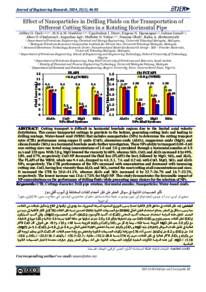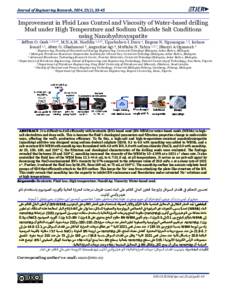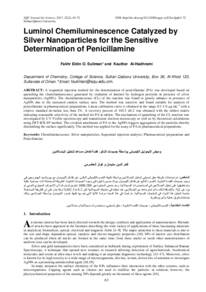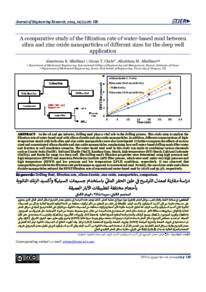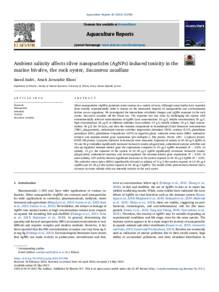Document
Effect of nanoparticles in drilling fluids on the transportation of different cutting sizes in a rotating horizontal pipe.
Identifier
DOI:10.53540/tjer.vol.21iss1pp46-58
Source
Journal of Engineering Research, v. 21, no. 1, p. 46-58.
Contributors
Norddin, M. N. A. M., Author
Duru, Ugochukwu I., Author
Ngouangna, Eugene N., Author
Ismail, Issham, Author
Gbadamosi, Afeez O., Author
Agi, Augustine, Author
Yahya, Muftahu N., Author
Abuhoureyah, Rafeq A., Author
Other titles
تأثير الجسيمات النانوية في سوائل الحفر على نقل أحجام الفتات المختلفة في أنبوب أفقي دوار.
Country
Oman
City
Muscat
Publisher
College of Engineering, Sultan Qaboos University.
Gregorian
2024-08-14
Language
English
English abstract
Cutting transport is difficult in horizontal borehole regions due to the limited axial velocity
distribution. This causes transported cuttings to gravitate to the bottom, generating cutting beds and leading to
drilling mishaps. Water-based mud (WBM) that includes nanoparticles (NPs) to determine the cutting transport
ratio (CTR) performance using copper II oxide (CuO), aluminium oxide (Al2O3), magnesium oxide (MgO), and
silicon dioxide (SiO2) in a horizontal borehole needs further investigation. These NPs ability to transport 0.80–3.60
mm cutting sizes was tested using concentrations of 1.0 and 2.0 g circulated through a horizontal annulus at 3.5
m/s and 120 rpm. With 2.0 g, MgO lowered the viscosity by 60%, whereas SiO2, CuO, and Al2O3 increased it by 49%,
10%, and 87%, respectively. CuO NP decreased the fluid loss (FLAPI) the best, followed by MgO, SiO2, and Al2O3.
The FLAPI of the WBM, which was 9.4 mL, dropped to 4.8, 5.1, 7.4, and 8.2 mL with CuO, MgO, SiO2, and Al2O3
NPs, respectively. The CTR performance of the NPs increased with concentration and decreased with increasing
cutting size. CuO, having less viscosity than Al2O3 and SiO2, carried the most cutting at all concentrations and sizes.
It increased the CTR by 28.8–31.1%, whereas Al2O3 and SiO2 increased it by 22.7–26.7% and 16.7–22.2%,
respectively. The lowest increase was 13.6–17.8% for MgO NP. This study demonstrates the favourable impact of
NP concentrations on the performance of drilling fluids while presenting many choices for the selection of NPs.
ISSN
Online: 1726-6742
Print: 1726-6009
Arabic abstract
تُعد عملية نقل الفتات في مناطق الآبار الأفقية تحديًا بسبب التوزيع المحدود للسرعة المحورية، مما يؤدي إلى تراكم الفتات في القاع وتشكيل طبقات منه. تناولت هذه الدراسة استخدام سوائل الحفر القائمة على الماء (WBM) مع جسيمات نانوية من أكسيد النحاس (CuO)، أكسيد الألومنيوم (Al2O3)، أكسيد المغنيسيوم (MgO)، وثاني أكسيد السيليكون (SiO2) لتحسين نسبة نقل الفتات (CTR). تم اختبار الجسيمات بتركيزين (1.0 و2.0 جم) عبر حلقة أفقية بسرعة 3.5 م/ثانية و120 دورة/دقيقة. أظهرت النتائج أن أكسيد المغنيسيوم قلل من اللزوجة بنسبة 60٪، بينما زاد كل من أكسيد الألومنيوم وأكسيد النحاس وثاني أكسيد السيليكون اللزوجة بنسب متفاوتة. كما ساهمت الجسيمات النانوية في تقليل فقدان السوائل وتحسين نقل الفتات، حيث كان أداء أكسيد النحاس الأفضل في نقل الفتات مقارنة بالجسيمات الأخرى. بشكل عام، تقدم الدراسة خيارات متعددة لتحسين أداء سوائل الحفر باستخدام الجسيمات النانوية.
Category
Journal articles

